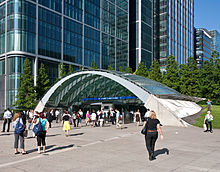Canary Wharf Underground Station
Canary Wharf is an underground station on the London Underground in the London Borough of Tower Hamlets . It is located in tariff zone 2 in the middle of the steadily growing skyscraper district Canary Wharf in Docklands . In 2014, 51.81 million passengers used this station served by the Jubilee Line . The Canary Wharf station of Crossrail , which will open in December 2018 is, about three hundred meters to the north and is not directly connected to the subway station.
history
The official opening took place on September 17, 1999 by Mayor Ken Livingstone . Before the Jubilee Line extension towards Stratford was built, public transport links in Docklands were relatively poor. Although the Canary Wharf station of the Docklands Light Railway has been in operation since 1987 , the planners had already realized by 1990 that its capacity would soon be exhausted. With the Jubilee Line, the expected rapid increase in the number of passengers should be managed.
Canary Wharf station and the extension of the Jubilee Line were partially funded by the owners of Canary Wharf. Just a few years after the opening, it appears that the capacity limit will be reached again in the near future. A new signaling system, which allows the trains to be closer together, is supposed to provide relief. The trains were also extended from six to seven cars. In the long term, Line 1 from Crossrail will provide another rail link to Canary Wharf and further relieve the Jubilee Line.
In 2002, individual scenes from the film 28 Days Later were shot in the station . The film Rogue One: A Star Wars Story was also shot here.
investment
Although there is a station of the same name on the Docklands Light Railway , it is not part of the underground station. Heron Quays station is even closer. All three stations are connected to one another underground by shopping arcades.
From the beginning, Canary Wharf was planned as a showpiece of the Jubilee Line extension and the renowned architect Norman Foster was commissioned to develop the design. The station was built in a former harbor basin that had been pumped empty and a pit 24 meters deep and 265 meters long was created using the open construction method . The volume of the station is reminiscent of a cathedral.
On the surface of the earth, there is little evidence of the huge interior. Two curved glass canopies at the eastern and western ends of the station span the entrances and allow daylight to shine through to the distribution level . A public park is located between the two canopies. The original plan was to fill the area between the canopies with water. But this turned out to be technically not feasible, which is why the park was created.
As in the other tunnel stations of the Jubilee Line extension opened in 1999, the platforms in Canary Wharf are separated from the tracks by platform screen doors .
Web link
Individual evidence
- ↑ COUNTS - 2014 - annual entries & exits. (PDF, 44 kB) (No longer available online.) Transport for London, 2015, archived from the original on February 21, 2016 ; accessed on December 29, 2017 (English). Info: The archive link was inserted automatically and has not yet been checked. Please check the original and archive link according to the instructions and then remove this notice.
- ↑ Jubilee Line. Clive's Underground Line Guides, accessed January 8, 2013 .
- ^ Filming locations for 28 days later. Internet Movie Database, accessed January 8, 2013 .
- ↑ Rogue One: A Star Wars Story (2016) - IMDb. Retrieved June 8, 2020 .
| Previous station | Transport for London | Next station |
|---|---|---|
| Canada Water |
|
North Greenwich |
Coordinates: 51 ° 30 ′ 12.6 ″ N , 0 ° 1 ′ 7.1 ″ W.


